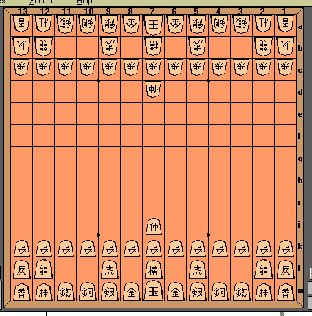
Heian-Dai Shogi is so named as it dates from 'Heian' times. The game is noteworthy as being the earliest known Shogi variant, and was described in some detail in a history text entitled NICHUREKI dated between 1126 and 1130.
There is some doubt as to the exact moves and promotions of the pieces. The rules used in this program are in accordance with recent research on the game in Japan.
The pieces in Heian-Dai Shogi have limited powers of movement and captured pieces are not returned to play. The game is much slower and on the whole less interesting than later variants. Heian-Dai Shogi is therefore primarily of historical interest only.
The pieces are flat and wedge-shaped and are not distinguished by colour. Although the pieces are of uniform colour the first player is still conventionally referred to as 'Black' and the second player as 'White'. Ownership of the pieces is indicated by the direction in which they face, with a player's pieces always pointing towards the opponent.
The players make alternate moves, with the object being to capture the opposing 'King'.
As in orthodox chess, when a 'King' is about to be captured next move and no legal move can be made to prevent the capture, the piece is said to be 'Checkmated'.
In common with other ancient chess games, the game can also be won by capturing all pieces except the 'King' (the 'bare king' rule). A bare King may secure a draw if it can also bare the opposing 'King' on the following move.
On each turn a player can move one piece according to its power of movement to a vacant square on the board, or to a square occupied by an enemy piece (in which case the enemy piece is captured and removed from the game).

On the first row, each player has from left to right: a Lance, Knight, Iron General, Copper General, Silver General, Gold General, King, Gold General, Silver General, Copper General, Iron General, Knight, Lance. On the second row, from left to right: Free Chariot, Flying Dragon, two empty squares, Fierce Tiger, empty space, Side Mover, empty square, Fierce Tiger, two empty squares, Flying Dragon, Free Chariot. On the third row, there are thirteen pawns. The fourth row has on the middle square a go-between.

All pieces except the 'Flying Dragon' promote to 'Gold General' (in the case of the 'Pawn' the promoted form is called 'Tokin'). On promotion the 'Flying Dragon' gains the power to move one square orthogonally.
Promotion is not compulsory unless the piece would be unable to make a further legal move in its unpromoted state. The 'Pawn','Lance' and 'Iron General' must therefore promote on reaching the last rank (that furthest from the player) and the 'Knight' must promote if it reaches either of the last two ranks. There can be advantages with some pieces of not promoting immediately on entering the Promotion Zone.
As in all the games in the Shogi family, the promoted rank is shown on the reverse side of the piece, and the piece is turned over on promotion to reveal the new rank.